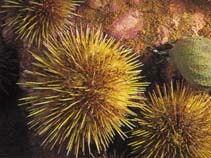Strongylocentrotus droebachiensis (Müller, 1776)
Northern sea urchin| Native range | All suitable habitat | Point map | Year 2050 |

|
| This map was computer-generated and has not yet been reviewed. |
| Strongylocentrotus droebachiensis AquaMaps Data sources: GBIF OBIS |
Classification / Names Populärnamn | synonymer | CoL | ITIS | WoRMS
Echinoidea | Camarodonta | Strongylocentrotidae
Environment: milieu / climate zone / djupintervall / distribution range Ekologi
; djupintervall 0 - 300 m (Ref. 78719), usually 0 - 50 m (Ref. 113749). Temperate; 79°N - 37°N, 127°E - 97°E
Distribution Länder | FAO områden | Ekosystem | Förekomster | Utplanteringar
Northern Pacific, Northern Atlantic and the Arctic. Temperate to polar.
Length at first maturity / Size / Weight / Age
Könsmognad: Lm 2.5 range ? - ? cm Max length : 10.0 cm WD hane/ej könsbestämd; (Ref. 865); rapporterad maxålder: 45 år (Ref. 90469)
Life cycle and mating behavior Könsmognad | Reproduktion | Lek | Eggs | Fecundity | Larvae
Main reference
referenser | Koordinator | Medarbetare
Berkes, F., T.P. Hughes, R.S. Steneck, J.A. Wilson, D.R. Bellwood, B. Crona, C. Folke, L.H. Gunderson, H.M. Leslie, J. Norberg, M. Nyström, P. Olsson, H. Österblom, M. Scheffer and B. Worm 2006 Globalization, roving bandits, and marine resources. Science. 311:1557-1558. (Ref. 861)
IUCN Red List Status
(Ref. 130435: Version 2025-1)
CITES status (Ref. 108899)
CMS (Ref. 116361)
Threat to humans
Human uses
Fiskeri: kommersiell
| FishSource | Sea Around Us
Verktyg
Ytterligare information
Max. ages / sizes
Length-weight rel.
Length-length rel.
Length-frequencies
Mass conversion
Abundans
Internet-källor
BHL | BOLD Systems | CISTI | DiscoverLife | FAO(Publication : search) | Fishipedia | GenBank (genome, nucleotide) | GloBI | Gomexsi | Google Books | Google Scholar | Google | PubMed | Tree of Life | Wikipedia (Go, sök) | Zoological Record



